Visit your favourite destinations |
Doñana's Northern Marshes. Two days in the field with John Butler
Visit: Johns Web Site Contact: John Butler
To visit Spain's Doñana National Park had long been a dream of mine, so when John Butler (Doñana expert and author of Birdwatching on Spains Southern Coast) offered me the chance of two action packed days of birding with him, I jumped at the chance.
Superlatives can't do Doñana justice, this is Spain and indeed Europe's biggest wetland area. It has colonies of Storks, Flamingo's, Spoonbills, Ibis's, Egrets and Herons that number in the thousands. When a flock 500 White Storks suddenly take off and fly low overhead it is a truly awe inspiring sight. Add to this a supporting cast of numerous species of Raptors (which seem to line all the roadside powerlines), Azure-winged Magpies, Purple Swamp Hens, Shrikes, Warblers and Waders and you just know that you are in for a never to be forgotten experience.
Day 1
I was travelling up from the Costa Del Sol, and so I met John at the Laguna Medina which was a suitable halfway point. It was late July, this is not the best time to be birding in Spain, it can be oppressively hot and the small birds have all stopped singing, but there are still plenty to be seen.
One or two pairs of Crested Coot are present at the Laguna Medina but distance and heat haze made identification from the thousands of pairs of Common Coot all but impossible. However, easy to see were hundreds of Greater Flamingo's, good numbers of White-headed Ducks, Red-crested Pochard, a single Purple Swamp Hen and good no's of waders.
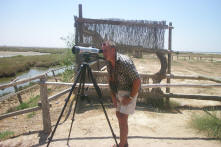 |
Our next destination was to be Doņana's eastern fringes along the east bank of the Rio Guadalquivir. We stopped at the Laguna de Tarelo, drove through the Pinar de Algaida (a potential site for Azure-winged Magpies - though these are much more easily seen in Doņana proper) and finally to the Salinas de Monte Algaida, a superb site and one that I would never have found without John's help. Highlights here were at least five Slender-billed Gulls (a lifer for me), flocks of Spoonbills totaling well over a thousand birds, large numbers of Whiskered Terns, White Storks, Herons, Egrets and waders galore. |
| Following this feast of birds we headed north up the banks of the Rio Guadalquivir, through Seville and then back down into the heart of Doņana. We started by hitting the well known bird watching centres, first stop the beautiful Arroyo de la Rocina near El Rocio. Bee-eaters flew overhead as we got out of the car and Azure-winged Magpies could be heard calling in the distance, which would soon give us good views. A raised boardwalk, through shady Pines, lead to hides overlooking a large lagoon. Ruff and Green Sandpipers hinted at the start of return wader migration. Woodchat Shrikes kept us company as we walked through the trees. | 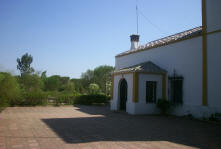 |
 |
El Acebuche was our next port of call. This is THE site for Azure-winged Magpies. John put bread onto the picnic tables and within a few seconds the magpies had taken it. Nature trails, lead to more lagoons with similar birds to the Arroyo de la Rocina. Lots of scrub species could be heard as we walked through. |
We finished our day on the roof of the SEO bird observatory at El Rocio. The lagoons were rapidly drying out, and were a pale shadow of their spring time glory, though there were still hundreds of birds to be seen.
I stayed with John and his delightful wife Beccy for the night. I was wonderfully fed and watered and, perhaps for the first time, was able to experience the "real" rural life of Spain, well away from the rush and bustle of the Costa's. My sincere thanks go to them both for a memorable evening.
Day 2 (Full Itinerary)
Today was to be my visit to the hidden Doņana, the Northern Marshes, away from the tourist hoards. A land of desolate and wild beauty, with new birds around every corner. I couldn't wait.
At this point I have to say that I couldn't have done this trip without John, his intimate knowledge of every twist and turn in the mainly un-signposted roads and most importantly the locations of the breeding sites for most of the key species, made his help invaluable. His four wheel drive also gave us untroubled access to the rougher by-ways.
We quickly picked up a flock of Collared Pratincoles hawking for insects over a recently cultivated field. A couple of Montagu's Harriers paralleled the road a little further on.
| Our first intended stop was the Dehesa de Abajo. An incredible site, numerous Purple Heron's took flight as we pulled up. Purple Swamp Hens kept poking their heads out of the reeds, Whiskered Terns were everywhere. John had a staked out Crested Coot nest at the back of the reserve, but regrettably it had been deserted just the week before. The Dehesa de Abajo has the largest White Stork colony in Europe, a thousand pairs has been mentioned. This was also to be the site that we saw our first Glossy Ibis's. | 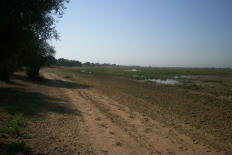 |
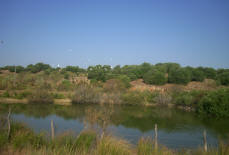 |
Driving along though the Isla Mayor we came across a series of small pools with an amazing Heron roost. The highlight for me was the flock of twenty or more Black-crowned Night Heron's. Squacco Heron's also featured among the many Little and Cattle Egrets. |
| A long straight road along the Cano de Guadiamar produced a seemingly constant stream of raptors: Black Kite were by far the most common but we also had about ten each of Short-toed Eagle and Booted Eagle. Buzzard, Kestrel, Marsh and Montagu's Harriers also featured. Many small larks flew up from the road. Lesser Short-toed and Crested were the easiest to see. Spectacled Warblers kept appearing in the most unlikely places. | 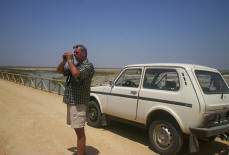 |
The Jose Antonio Valverde Visitors Centre is deep into the Park and normally quite hard to find. It was very good for the reed bed species. Apparently over 800 Glossy Ibis' were ringed there this year. We saw lots. Squacco Herons gave very close views but the Little Bitterns kept temselves hidden. John also had another Crested Coot stakeout nearby, again they had left their nest just the week before.
Our total list for the two days was about 90, very good for the time of year especially considering that we were only targeting the wetland species. I would love to visit during the Spring or Autumn migration, when numbers are boosted by hundreds of thousands of birds heading to and from Northern Europe. A spectacle indeed.
John is available for tours throughout the year. Visit: Johns Web Site Contact: John Butler
(Northern Marshes Itinerary) (Johns Book)
|
Back to Birdtours.co.uk
|
|
||